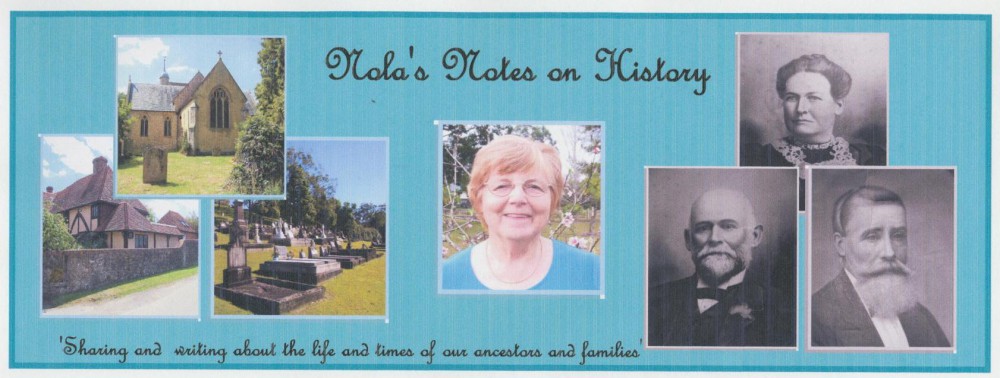My 2x Great Grandfather, George Bell was born in East Farleigh, Kent, England in 1817.
In 1837 he and his brother, James emigrated to Australia as sailors on a convict ship.
George Bell married Sarah Sargent at Sutton Forest, New South Wales in 1844.
See Our Bell Family in Australia- George Bell’s Marriage 1844
This couple settled in Picton, New South Wales, and had a family.
Their children were all born in Picton, New South Wales.
George Bell Jr was born in 1845 and baptized in 1846.
See Our Bell Family in Australia – George Bell, 1846, Picton.
He was named for his father.
James Bell was born and baptized in 1847.
See Our Bell Family in Australia – James Bell,1847, Picton.
He was named after his uncle, his father’s older brother who immigrated with him.
Thomas Bell was born in 1849.
See Our Bell Family in Australia – Thomas Bell, 1849, Picton.
He was named for his Paternal and Maternal grandfathers.
According to the Bell Family Bible, I have, after three sons, George and Sarah Bell had a daughter. She was called Harriet, after George Bell’s, sister who had died in East Farleigh, Kent, when George was six years of age.
Harriet Bell was born in 1852
See Our Bell Family in Australia – Harriet Bell, 1852, Picton.
Henry Bell was born in 1854
See Our Bell Family in Australia – Henry Bell, 1854, Picton.
He is believed to have been named for his mother’s younger brother, Henry Packham Sargent.
John Bell was born in 1856.
See Our Bell Family in Australia – John Bell,1856, Picton
Emma Bell was born in 1859.
See Our Bell Family in Australia – Emma Bell, 1859. Picton
The Bell family bible listed the next child as a daughter, named Alice with a birth date given as the 21st January 1863.
I checked for her baptism.
I found an entry on Ancestry.com website which was for St Marks Anglican Church, Picton. Sourced from the Anglican Parish Registers for the Sydney Diocese. This I was able to download to add to my records.
I have made a transcription of this record. See below.

I checked for references in the online index of the Registrar of Births Deaths and Marriages in New South Wales in Sydney at https://bdm.nsw.gov.au/ .
I found this entry and was able to apply for a birth certificate.
BELL ALICE, 12460/1863 dau of GEORGE and SARAH registered PICTON
My transcription to share is below.

There was no Birth Notice in a newspaper.
As all the above sources give the same date of birth I feel confident that was her birth date.
It is believed that Alice was named for her Maternal Grandmother, Ellis or Alice Sargent(nee Packham). She had separated from her husband and four eldest children and journeyed to South Australia with a new partner and younger children in about 1846. She died a few months after Alice Bell’s birth, but it is not known if she knew she had a granddaughter named for her.
It would appear that with the opening of St Mark’s Anglican Church in Picton that this church became the family church.
Alice Bell was only two years of age when her mother died. She was raised by her sister Harriet and sister-in-law Ellen Bell. Her father did not remarry.
History of St Mark’s Picton.

| The foundation stone of – St Mark’s Church, Picton – was laid by the Rev Edward Rogers – Minister of the Parish – on the 16th day of July AD 1850 – J M Antill, J Templeton, T Larkin, J Crispe ~ Building Committee. A heritage plaque displayed in the grounds records that the original church was opened in 1856. The first Anglican services were held in 1825 at the home of Major Antill, one of the first European settlers in the Picton area. When a small court house was built on the Major’s property (he was the Police Magistrate, and the family served the local court for three generations), services were held there. – The local rector was the Reverend Thomas Hassell of Denbigh, Cobbity, and his parish stretched to Goulburn, across to Wollongong, and south to Mulgoa. In 1839 the Reverend Frederick Wilkinson had a smaller area to cover, from his house at the Hermitage, The Oaks. Next came the Reverend Edward Rogers from 1848, and by now money was being raised to build a church on land donated by the Antill family, in Menangle Street West. The foundation stone was laid in July 1850, the church being designed by Edmund Blacket, with Thomas Smith, G Wandess, and Barnsdale as masons. T Cashman and John Iceton as carpenters. Whitfield doing the ironwork, painting by W Brown, and fencing by Abel Sant and Rosette. Unfortunately, the work went very slowly, as the gold rushes affected the supply of labour, and it was not completed until 1856. – The original church was tiny, and as the town grew in the 1860s with the arrival of the railway line, so the nave was extended 12 feet, and a vestry was added. Then in 1886 Blacket’s sons, Cyril and Arthur designed the transepts which provided even more room. The original wooden shingles were replaced with slate in 1904, and then by tiles in 1930. Oil lamps were used for lighting until 1922 when electricity was connected. – The earliest burials in the graveyard date from 1858, though severe flooding in the 1860s and later has affected those graves closest to Stonequarry Creek, as well as the church. Although levy banks provide some protection now, severe flooding can still occur. The building, its furnishings, and the organ were badly impacted by the 2016 floods, together with the pioneer cemetery. It has now been restored. [1] [1] Sourced From <https://www.churchesaustralia.org/list-of-churches/locations/new-south-wales/n-s-towns/directory/8327-picton-anglican-church> |
































 Extract from an image – Bell-Sargent Marriage,1844 downloaded from Ancestry.com, by Nola Mackey,1st August 2020.
Extract from an image – Bell-Sargent Marriage,1844 downloaded from Ancestry.com, by Nola Mackey,1st August 2020.